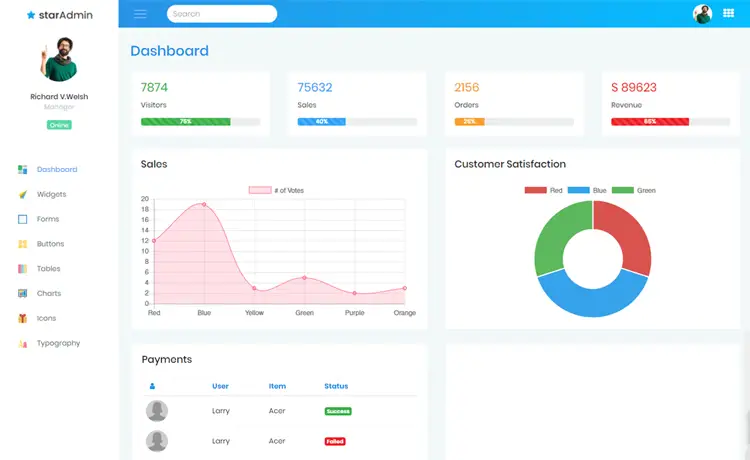How to disable ModelStateInvalidFilter in ASP.NET Core
By Tan Lee Published on Feb 04, 2025 895
If you want to disable this automatic behavior, you can configure it globally or locally in your controllers.
Why Disable ModelStateInvalidFilter?
Disabling the ModelStateInvalidFilter gives you the flexibility to manually perform model validation in your application, allowing you to handle the validation errors in a custom way. This can be useful if you need more control over the error handling process or if you want to return a custom error response.
1. Disable ModelStateInvalidFilter Globally
If you want to disable ModelStateInvalidFilter for all actions in your API, you can do so by configuring the ApiBehaviorOptions in the ConfigureServices method. By setting SuppressModelStateInvalidFilter to true, you will globally disable the filter.
public void ConfigureServices(IServiceCollection services)
{
services.AddControllers().ConfigureApiBehaviorOptions(options =>
{
// suppressmodelstateinvalidfilter asp.net core
options.SuppressModelStateInvalidFilter = true;
});
}Once this is done, the framework will no longer automatically return a 400 Bad Request when the model validation fails. Instead, you'll need to manually check the ModelState in your controller actions.
2. Disable ModelStateInvalidFilter for Specific Actions
If you only want to disable the filter for specific actions, you can implement a custom IActionModelConvention attribute. This approach allows you to remove the ModelStateInvalidFilter only from the actions where you want to disable it.
Step 1: Implement the IActionModelConvention Attribute
First, you need to create a custom attribute that implements IActionModelConvention to remove the ModelStateInvalidFilter from the action filters.
using Microsoft.AspNetCore.Mvc.ApplicationModels;
[AttributeUsage(AttributeTargets.Method, AllowMultiple = true)]
public class DisableInvalidModelFilterAttribute : Attribute, IActionModelConvention
{
private const string FilterName = "ModelStateInvalidFilterFactory";
public void Apply(ActionModel action)
{
// Search for the action filter and remove it
for (var i = 0; i < action.Filters.Count; i++)
{
if (action.Filters[i].GetType().Name == FilterName)
{
action.Filters.RemoveAt(i);
return;
}
}
}
}This custom attribute looks for the ModelStateInvalidFilterFactory filter and removes it from the list of filters for the action.
Step 2: Apply the Attribute to Specific Actions
After you’ve created the DisableInvalidModelFilterAttribute, you can apply it to the actions where you want to disable the ModelStateInvalidFilter.
[ApiController]
[Route("[controller]")]
public class StocksController : ControllerBase
{
[HttpPost]
[DisableInvalidModelFilter] // Disable the ModelStateInvalidFilter for this action
public IActionResult Post(StockOrder stockOrder)
{
// Manually validate the model state or perform other logic
if (!ModelState.IsValid)
{
return BadRequest(ModelState); // You can handle the error here
}
return Ok(stockOrder);
}
}With this approach, the ModelStateInvalidFilter will be disabled only for the Post action of the StocksController. The other actions in your controller will still use the default model validation behavior.
Conventions Only Run Once
You might be wondering if adding the IActionModelConvention to your actions will slow down your requests. The good news is that the framework only runs these conventions once during the application’s initialization. They don’t get executed with each incoming request, so performance will not be impacted.
Cannot Remove Custom Filters: This approach works only for built-in filters like ModelStateInvalidFilter. If you’ve added custom action filters to your application, this method will not work for removing them. The reason is that custom action filters aren’t available in Action.Filters during the IActionModelConvention execution phase.
Disabling the ModelStateInvalidFilter in ASP.NET Core gives you full control over model validation handling. You can choose to disable it globally for your entire application or selectively disable it for specific actions.
- Implement security headers for an ASP.NET Core
- How to add security headers to an ASP.NET Core Application
- How to Initialize TagHelpers in ASP.NET Core with Shared Data
- Boost Your ASP.NET Core Website Performance with .NET Profiler
- The name 'Session' does not exist in the current context
- Implementing Two-Factor Authentication with Google Authenticator in ASP.NET Core
- How to securely reverse-proxy ASP.NET Core
- How to Retrieve Client IP in ASP.NET Core Behind a Reverse Proxy





